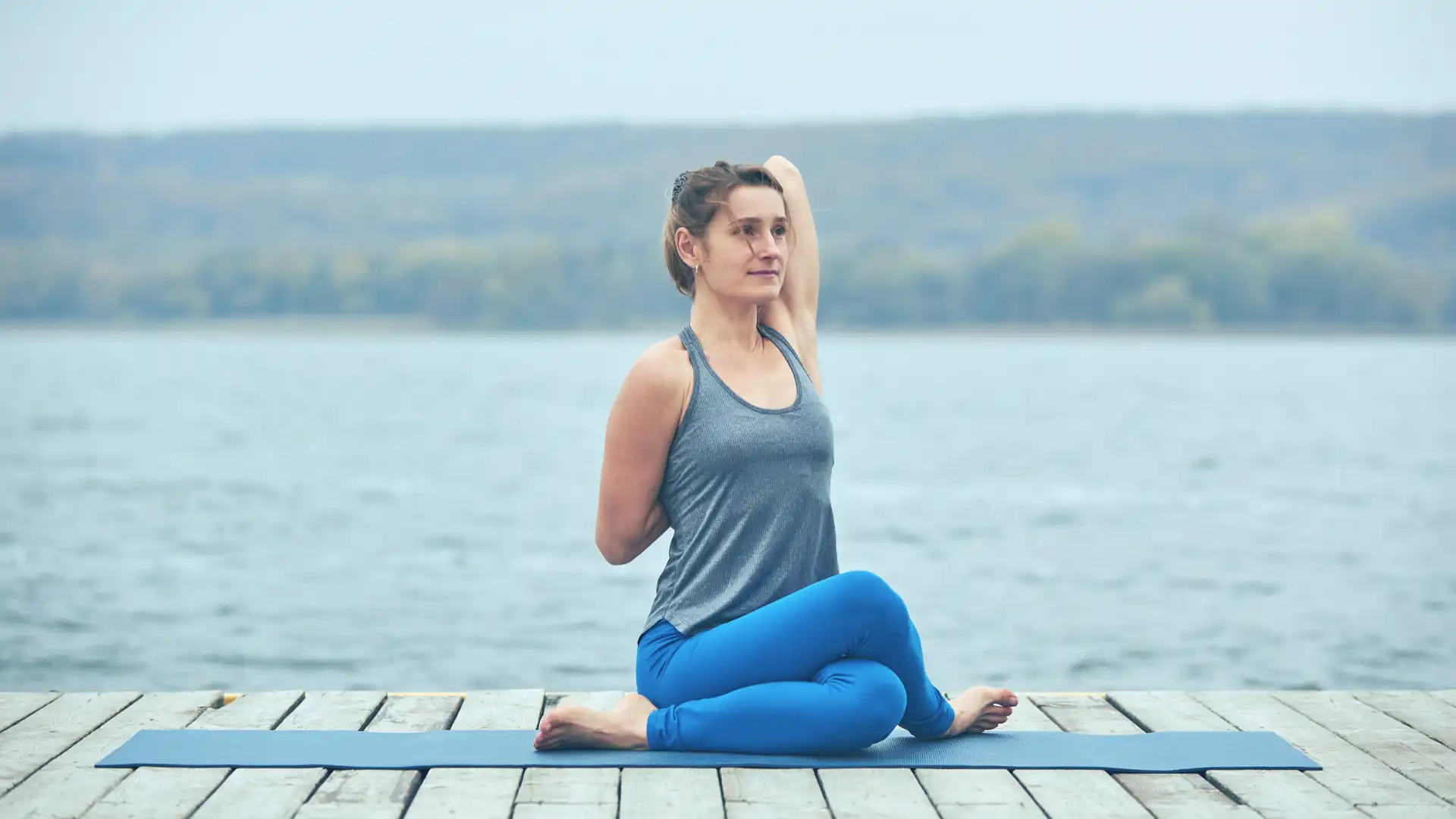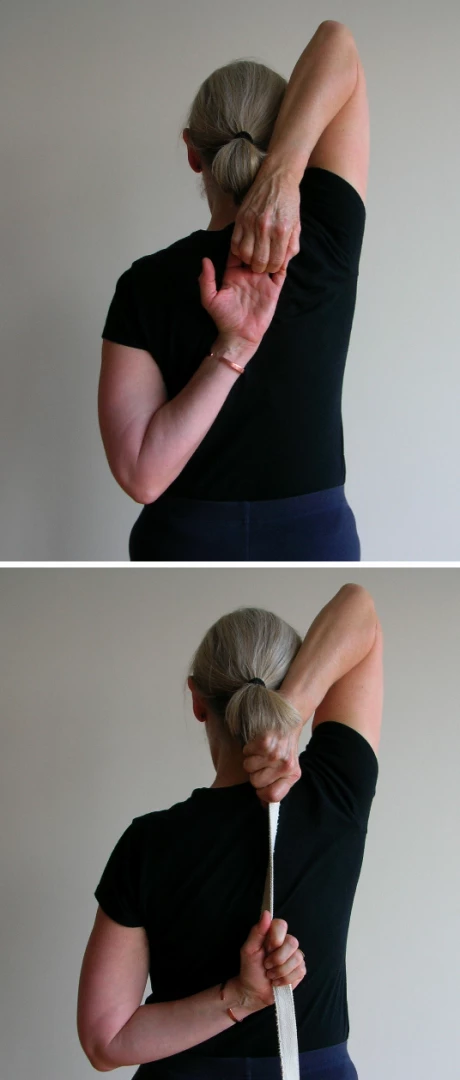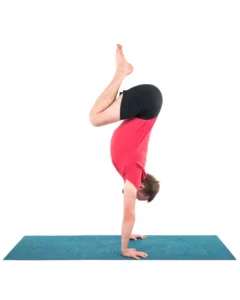Gomukhasana Arms: A 5-Minute Yoga Hack for Your Shoulders

When I’m not practicing or teaching, I’m often sitting at my laptop, writing, answering emails, doing everything that studio administration, blog posts, and finishing the instruction manual for building a bear-proof composter demand. So I’m well acquainted with the feeling of popping out of a period of concentration—really, that was an hour?—only to find my shoulders up around my ears, and my head poked forward in full turtle posture.
There are really only two alternatives. Ignore it, and shoulder tension will feed into a chain of reactions that go from stiff shoulders into sore necks, headaches, and beyond. Or deal with it: Stand up, take five minutes, and do this five-minute yoga challenge: stretch your shoulders in Gomukhasana (Cow Face Pose).
Stretch Your Shoulders, Relax Your Neck 
If you spend five minutes working your shoulders once a day, every day, for a week or longer, you may be surprised by the results. In your yoga practice, look for a new sense of freedom in Adho Mukha Svanasana (Downward Facing Dog Pose), more ease in Salamba Sarvangasana (Shoulderstand Pose), more lightness in Salamba Sirsasana (Headstand Pose).
In day-to-day life, any ease you bring into your shoulders will also reduce tension in your neck. Check for an unaccustomed sense of lightness and more clarity of thought. If you usually carry the weight of the world on your shoulders, stretching them will allow you to shift the burden.
Do your five shoulder-stretching minutes twice a day, taking breaks from whatever task it is that has brought them up around your ears, and you’ll more than double the benefits.
A 5-Minute Shoulder Stretch
- Stand in Tadasana or sit in a chair.
- Take your left hand behind your back. Rest the back of your hand on your sacrum. Notice that your left shoulder rolls forward. Lift your left upper arm bone and roll your shoulder back as you move your left hand up your back. Use your right hand at your left elbow to help guide your left hand into place. Line up the middle finger with your spine. (Make sure your shoulder stays open as you bring your hand up your back.)
- Check the front of your left shoulder. If it’s strongly rotated forward, slide your left hand down lower on your back. Find the position where you feel a stretch through your left arm but can still roll your shoulder back.
- Extend your right arm up toward the ceiling. Stretch up through your right side, all the way from your fingertips to your hips.
- Roll the little finger side of your hand toward your face and lengthen your right side even more. Now bend your right elbow, pointing the forearm downward, and connect your hands.
- If there’s a gap, hang a strap over your right shoulder and hold the strap with both hands.
- Look out at eye level, with your chin slightly dropped. As you inhale, roll your right arm toward your face and lift your elbow to the ceiling. As you exhale, let your left elbow sink toward the floor.
- If you are standing, move your front ribs away from your tee shirt, toward your spine. Make sure your weight is in your heels. If you’re sitting, press your sitting bones strongly into the chair.
- Hold the pose for one to two minutes. Release your arms and allow them to hang by your sides, feeling the residue from the stretch.
- Change sides. One side will be easier than the other, usually the side with the dominant arm up. Once you know your sticky side, try starting on that side, and repeating it after you’ve done the easy side.
 Benefits: Gomukhasana arms free the shoulder joints, creates length in the ribcage, and stretches the latissimus dorsi—the bodybuilders’ “lats.” That makes it a gateway pose, one that will open up a host of other important asanas, including Headstand and Shoulderstand
Benefits: Gomukhasana arms free the shoulder joints, creates length in the ribcage, and stretches the latissimus dorsi—the bodybuilders’ “lats.” That makes it a gateway pose, one that will open up a host of other important asanas, including Headstand and Shoulderstand
Sequence: For the best results, work with Gomukhasana more than once a day. Do it as a computer break to relieve tension in your shoulders. Take five minutes before you go to bed, or, if you don’t mind people staring, try it any time you find yourself sitting and waiting.
As part of a longer practice, do Gomukhasana once your shoulders are warmed up from Downward Facing Dog Pose and standing poses. It’s especially useful as a preparation for Shoulderstand.
Ouch: Truth be told, Gomukhasana is rarely comfortable, especially at the beginning. The shoulder of the lower arm lodges the loudest complaint. If you can’t smile and relax your eyes, ease off. Lower your bottom hand and use a strap to connect your hands. Work at a level that is intense and yet pleasant.
Watch for tension in your neck. You may be pulling your head forward. If the tension doesn’t decrease when you move it back into line, relax your pose and do less. If you have existing neck or shoulder problems, check with your teacher before trying this pose.
Sanskrit Corner: Say: Go-moo-KAHS-anna. Go means “cow.” Mukha means “face.” Asana means pose.
Also, read...
The Yoga Sutras: Practicing Non-Attachment without Becoming Detached
The Broomstick Effect: The #1 Key to Perfecting Balancing Yoga Postures
Related courses
Breath as Medicine: Yogic Breathing for Vital Aging
Yoga and Myofascial Release: Releasing Chronic Tension with the Bodymind Ballwork Method

Eve Johnson taught Iyengar Yoga for 18 years before being introduced to Spinefulness in 2016. Convinced by the logic, clarity, and effectiveness of Spinefulness alignment, she took the teacher training course and was certified in July 2018. Eve teaches Spineful Yoga over Zoom and offers an online Spinefulness Foundations course. For course information, go to http://spinefulness.ca.




